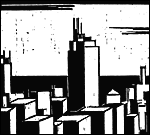Jennifer Toth, The Mole People: Life in the Tunnels Beneath New York City (Chicago Review Press, 1993) Reissued by Chicago Review Press in paperback in 1995. Following a wild tale from a student she tutored, Jennifer Toth descended into the subway system of New York in search of the legendary "mole people". These underground homeless residents had long been considered yet another New York urban legend, but Toth's journeys and the book that resulted proved otherwise. In the course of a year, Toth explored the "city beneath the street" and its warrens of drug-addiction, mental illness, mortal danger, and even love. Her book galvanized homeless advocacy groups and gained international attention. The estimates of underground homeless vary, but Toth supposes that there are about 5,000 people living in the tunnels beneath Manhattan. Toth's book focuses on a dozen or so of those people, with a peripheral cast of about a few hundred. She talks to Bernard, the "Lord of the Tunnels," a subterranean group of assassins who perform "hits" for as little as $20, a graffiti artist who sinks thousands of dollars into murals that will only be seen by these underground homeless, and many others. Their stories of despair, animalistic behavior, impromptu families, and hope interweave to create a haunting picture of life in the underground. Yet her closeness to her subjects may at times be her downfall. Several critics have faulted her naiveté; she makes little effort to confirm some of the wilder stories, and the reader sometimes wonders if our eager young guide into this world isn't being taken advantage of. To her credit, Toth makes clear from the beginning that this is personal journalism, and she portrays the world as its residents see it: uncertainty, lies and tall tales included. The trouble, however, is that the more stunning facts of her book are lost in the legends. When left to sort lies from truth, the reader errs in favor of disbelief and the book loses its impact. A far more serious consequence of her naiveté is her lack of attention to the policy issues surrounding the underworld. She avoids discussing the details of New York City's homeless policy and makes no mention of the resources it devotes to the problem. It is a glaring omission considering that Toth has entire chapters for seemingly peripheral topics like underground dwellers throughout ancient history and literature. We are told about the underground Cimmerian priests, but not how much money New York City spends on homeless shelters. This neglect includes the past as well as the present, as her grasp of policy history often comes from the people who lived it. This leaves her open to exaggeration and downright inaccuracy. This may be the fatal flaw of the book, and it makes Toth's exploration merely significant rather than ground-breaking. Yet the guts of the reporter who researched it and the compassion with which it is told redeem the book, and for these and other qualities it is highly recommended. MORE: AnnOnline Feature on Toth Unofficial New York City Subway Information Official New York City Subway Information Abandoned Subway Stations (with a link to a critique of Toth’s descriptions of the tunnels, alleging that she made up several of the locations) Burrowed Frontiers (somewhat more relevant than Toth’s explorations of the same subject, it also contains some references to The Mole People) Underground Cities (a discussion group for explorers and residents of the subterranean communities under several cities. Somewhat out of date, but still with much useful information) |
 |
|||||||||||||||||||||||||||